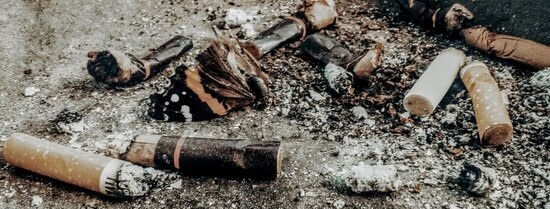High schools in the San Francisco Bay Area are being contaminated by plastics and toxic litter from e-cigarettes, cannabis products and combustible tobacco products such as cigarettes and cigarillos. The study of a dozen Bay Area high schools uncovered hundreds of waste items littering the parking lots and sidewalks in and around the schools. In addition to reflecting the widespread use of these products among teens, the researchers say these items are an environmental hazard due to the heavy metals, plastics, nicotine, lithium-ion batteries, and other toxins these products can contain. The paper publishes Oct. 10, 2019 in Morbidity and Mortality Weekly Report (MMWR), a scientific journal of the federal Centers for Disease Control and Prevention.
“We’re in the midst of an epidemic of teen e-cigarette use that is causing substantial toxic waste contamination at some high schools from teens discarding these products on the ground,” said first author Jeremiah Mock, PhD, a health anthropologist and associate professor in UCSF’s School of Nursing’s Institute for Health and Aging. He also is a member of UCSF’s Center for Tobacco Control Research and Education.
“But e-cigarettes are not the only problem,” Mock said. “Our research also shows that little cigars, cigarillos, and menthol cigarettes are popular at schools with large proportions of lower-income Latinx and African American families. These toxic products are contaminating school environments and surrounding areas, going down storm drains and contaminating the bay.”
The United States is experiencing an epidemic of vaping, especially by youth using flavored products. Often, the vaping takes place in the bathrooms, classrooms and parking lots at their schools.
From 2017 to 2018, e-cigarette use among U.S. high schools increased by 78 percent — from 12 percent of high school students to 21 percent — and by 48 percent among middle school students, according to the CDC. Communities in the Bay Area have been at the forefront of this epidemic: for example, in Marin County between 2016 and 2018, e-cigarette use among 11th graders rose 155 percent, from 11 percent to 28 percent, reports the MMWR study. JUUL, the dominant e-cigarette maker, is headquartered in San Francisco.
The Trump administration in September announced plans to ban flavored e-cigarette products, which account for a significant portion of the market. A recent analysis of the National Youth Tobacco Survey showed that among high school students who currently used e-cigarettes, the percentage who used flavored e-cigarettes increased from 65.1% in 2014 to 67.8% in 2018.
San Francisco and other cities and towns throughout the Bay Area are banning retail sales of flavored e-cigarettes and other flavored tobacco products including, menthol cigarettes; various commercial retailers are also ending e-cigarette sales. San Francisco has banned retail and internet sales of all e-cigarettes.
The new garbology study of environmental contamination was conducted at 12 public high schools in San Francisco, Contra Costa, Alameda and Marin counties.
The schools, which are not identified by name, were stratified by the percentages of students from low-income families. Researchers and student interns collected waste items from the student parking lots and exterior perimeter areas on a single day at each school between July 2018 and April 2019.
“Our study novelly detected the under-addressed problem of flavored little cigars and cigarillos in low-income youth populations,” said co-author Yogi Hale Hendlin, PhD, a public health scientist and environmental philosopher with appointments at Erasmus University Rotterdam and UCSF’s Environmental Health Initiative.
“Youth e-cigarette use — as epidemic as it is — seems to be lopsided towards higher-income student populations, with combustible tobacco product waste found in higher concentrations in lower-income schools,” he said.
Altogether, nearly 900 waste items were collected. The researchers found:
- Approximately 19 percent of the product waste was from e-cigarettes – nearly all of these were JUUL or JUUL-compatible pods and pod caps.
- Far more JUUL products were found at middle- and upper-income area schools.
- 73 out of 74 pod caps were from flavored pods other than tobacco flavors, including “Cool Mint,” “Cool Cucumber,” and “Classic Menthol.”
- At four high schools where the student populations are predominantly lower-income African American and Latinx, 71 little cigar or cigarillo plastic packages and mouthpieces were found; no such items were found at upper-income area schools.
- Across all the schools, 620 cigarette butts were collected, with 65 percent of identifiable butts being from recently smoked cigarettes.
“Action is needed to reduce youth tobacco smoking and cannabis access and use, and to eliminate environmental contamination from these products,” said Mock, who has started a crowdfunding site to engage parents and communities in addressing the problem. “Schools can engage students in garbology projects to clean up their schools and to raise awareness about the health and environmental hazards of these products.”

